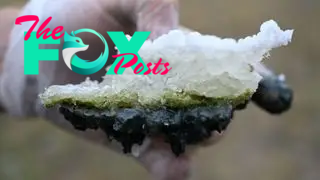Science
Last Chance Lake: The unusual 'soda lake' with conditions that may have given rise to life on Earth
Name: Last Chance Lake
Location: British Columbia, Canada
Coordinates: 51.32769655502273, -121.63335524817583
Why it's incredible: The lake's chemistry resembles conditions that may have given rise to life on Earth.
Last Chance Lake is a shallow, extremely salty pool of water with an unusual chemistry. The lake has phosphate concentrations 1,000 times higher than the ocean, making it a modern analog for conditions that may have given rise to life on Earth roughly 4 billion years ago.
Phosphate is an essential ingredient to make nucleotides — the building blocks of DNA and RNA — and other life-forming compounds, such as lipids. Although phosphate is bound up in every living being, the element by itself is scarce in nature.
"Someone coined the phrase 'the phosphate problem' for the origin of life, which is that you need a lot of phosphate for these reactions," Sebastian Haas, a postdoctoral researcher in the Department of Earth and Space Sciences at the University of Washington, told Live Science. "The second part of the problem is that phosphate is usually low in the environment, and the only real exception we know are these kinds of lakes."
Related: 'This is weird': Experts 'shocked' by record-breaking longevity of Death Valley's phantom lake
Last Chance Lake is one of several so-called "soda lakes" — lakes that have high levels of dissolved sodium and carbonate. That makes them similar to bowls of water containing large amounts of dissolved baking soda, hence the name. This chemical makeup enables these lakes to have high concentrations of phosphate.
In freshwater lakes, phosphate scarcely exists by itself because it binds to calcium to form calcium phosphate — an insoluble material. But in soda lakes calcium preferentially binds with carbonate and magnesium, freeing up phosphate.
"The high carbonate is sort of the key for the high phosphate in these lakes," said Haas, who led research into Last Chance Lake and neighboring Goodenough Lake for a study published in 2024 in the journal Communications Earth and Environment.

This high carbonate level, together with high sodium, results from a reaction between groundwater and volcanic rocks that sit beneath the lake, Haas said.
-

 Science8h ago
Science8h agoHow to See the ‘Beaver’ Supermoon—the last of 2024
-

 Science5d ago
Science5d agoInside Capitol Hill’s Latest UFO Hearings
-

 Science5d ago
Science5d agoYou Won’t Want to Miss the Leonid Meteor Shower. Here’s How and When You Can See It
-

 Science6d ago
Science6d agoHere’s What Trump’s Win Means for NASA
-

 Science1w ago
Science1w agoWhy Risky Wildfire Zones Have Been Increasing Around the World
-

 Science1w ago
Science1w agoIt’s Time to Redefine What a Megafire Is in the Climate Change Era
-

 Science1w ago
Science1w ago4 Astronauts Return to Earth After Being Delayed by Boeing’s Capsule Trouble and Hurricane Milton
-

 Science1w ago
Science1w agoThe Elegance and Awkwardness of NASA’s New Moon Suit, Designed by Axiom and Prada



























